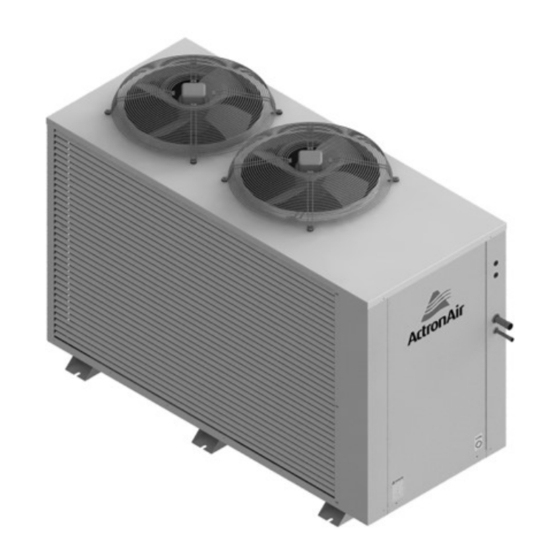
Table of Contents
Advertisement
Advertisement
Table of Contents

Summarization of Contents
Introduction
Information About This Guide
Provides installation instructions and emphasizes reading the manual for correct installation and safe operation.
Product Inspections
Instructions for checking the unit and components upon receipt and verifying nameplate details.
Codes, Regulations, and Standards
Emphasizes installer responsibility for compliance with codes, regulations, and wiring standards.
Safety Symbols and Labels
Explains the importance of paying attention to safety symbols and following instructions to avoid hazards.
Safety Instructions
Hazardous Voltage - Risk of Electrocution
Warns about hazardous voltage and requires power isolation and LOTO procedures before service.
Beware of Rotating Fans
Alerts to the danger of rotating fans and pinch points, recommending PPE and caution.
Visual Inspection and Work Assessment
Stresses the importance of assessing work areas and understanding unit parts before performing tasks.
Installation Information
Recover and Recycle Refrigerants
Prohibits venting refrigerant and mandates recovery, recycling, and reuse according to regulations.
Refrigerant Handling and Safety
Advises consulting MSDS for proper handling and understanding health, safety, storage, and disposal requirements.
Service Equipment and Recovery Procedures
Specifies the use of refrigerant reclaiming equipment and procedures for system evacuation and leak testing.
Unit Dimensions, Clearances, and Weights
Unit Dimensions
Presents diagrams and tables showing the overall nominal dimensions, mounting distances, and pipe connections.
Service Access, Airflow Clearances, and Weights
Details required service access areas, airflow clearances, and unit weights for proper installation and maintenance.
Unit Lifting Procedure
Crane Lifting Method
Describes the recommended procedure for lifting the unit with a crane, including required equipment and safety precautions.
Fork Lift Method
Details the safe procedure for lifting the unit using a forklift, including insertion points and precautions.
Field Pipe Connection
Piping and Brazing
Details the process of brazing refrigeration pipes, emphasizing cleanliness, nitrogen purging, and R-410A refrigerant handling.
Installing Interconnecting Pipe Work to Indoor, Nitrogen Bleed Procedure
Explains the nitrogen bleed procedure for connecting pipes between indoor and outdoor units during installation.
Installing Interconnecting Pipe Work to Outdoor, Nitrogen Bleed Procedure
Details the nitrogen bleed procedure for connecting pipes to the outdoor unit for brazing.
Electrical Installation
Live Electrical Supply
Warns about the dangers of live electrical supply during installation and stresses the need for qualified personnel.
Static Sensitive Electronic Devices
Advises caution when handling electronic devices, recommending anti-static precautions to prevent damage.
Wiring Diagram
Directs users to the wiring diagrams located inside the electrical access panel for installation and troubleshooting.
Supply and Power Requirements Procedure
Details installer responsibilities for providing power supply wiring, compliance with regulations, and isolator installation.
Compressor Voltage Balance Requirement
Explains the importance of balanced voltage for three-phase systems and how to check for imbalances.
Refrigerant Charging
Refrigerant Charge Details (R-410A)
Provides a table with factory charge, pre-charged length, and additional refrigerant amounts for different models.
Charging Method: Subcooling and Superheat
Describes the method of adjusting refrigerant charge based on superheat and subcooling readings for optimal performance.
Checking for Subcooling
Details how to measure and calculate subcooling to ensure the correct refrigerant charge in the system.
Checking for Superheat
Explains how to measure and calculate superheat for optimal evaporator performance and compressor protection.
Subcooling and Superheat Table
Presents a table with recommended subcooling and superheat ranges for cooling and heating operations.
Maintenance
Annual Maintenance Checklists
Lists routine inspection and maintenance tasks to be performed annually for optimal unit performance.
Cleaning the Condenser Coils
Provides instructions on how to clean the condenser coils to maintain efficient operation and prevent performance degradation.
Coil Cleaning Procedures
Details the step-by-step process for cleaning the condenser coils safely and effectively.
Maintenance Frequency Checklist
ELECTRICAL
Lists maintenance checks and service methods for electrical components like circuit boards and connections.
OUTDOOR UNIT
Details maintenance checks and service methods for outdoor unit components like casing, fan, motor, and heat exchanger.
Safety Devices
Covers calibration checks for safety devices such as HP/LP controls and sensors.
Faults
Describes checking for previous fault history and investigating causes for unit malfunctions.
Outdoor Fan Speed Capacitor
Details checking the fan speed capacitor for bulges and capacitance, ensuring electrical safety.
Start Up and Commissioning Report
Installation Information
Section to record customer, installer, site address, model, and serial number details.
Circuit Temperature Settings
Table to log supply air, return air, suction, discharge, condenser coil, and ambient temperatures for both systems.
Indoor Fan Settings
Section to record indoor fan current, airflow, PWM, and set static pressure.
Outdoor Fan Settings
Section to record outdoor fan current.
Check No Active Error Codes on the Unit
Field to indicate if any active error codes were present on the unit during commissioning.
















Need help?
Do you have a question about the SCA340C and is the answer not in the manual?
Questions and answers